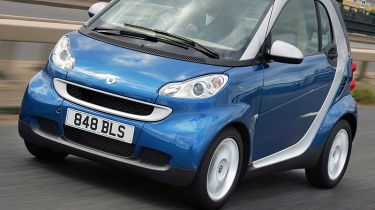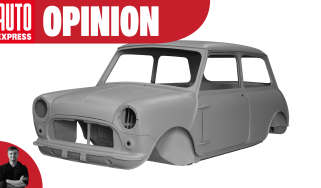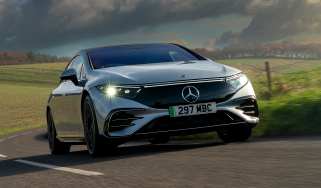Smart fortwo review
The unique ForTwo is both impressive and flawed.

Driving
The Smart comes with a 1.0-litre three-cylinder engine. We tested the 71bhp version (there’s also 61bhp and 84bhp turbo variants), and found it offered just enough performance. Top speed is limited to 92mph, but more importantly a 750kg kerbweight helps it to 60mph in 13.8 seconds. It’s less impressive for high-speed response, though. As with the old car, the automated manual gearbox has hesitant shifts, and there’s a pause between gears that causes the car to lurch back and forth. The steering is also heavy at low speeds which, added to the jerky throttle, makes manoeuvring difficult. And out of town, the short wheelbase and stiff ride mean the ForTwo is nervous and jarring on anything other than smooth surfaces. In corners, the inert steering weights up, but feels numb. While there’s plenty of grip, the stability control cuts in way before the tyres even begin to push wide, and the brake pedal is as stiff as its predecessor’s, making it hard to slow progressively (although actual stopping distances are admirably short).
Marketplace
Smart was never going to take a risk by changing the basic ForTwo concept too much; you have to look hard to tell the latest car from its predecessor. This means fans of the first car’s cheeky charm won’t be disappointed. It’s larger than the car it replaces, with 55mm added to the wheelbase, while it’s 43mm wider. Indeed, it’s nearly as wide as a Fiat Panda, although it’s the best part of a metre shorter. It has few genuine rivals, though its tiny dimensions make it a much safer, more grown-up alternative to models such as the electric G-Wiz. Mitsubishi offers the intriguing i, too, which seats double the number of people – as do more conventional city cars like the Fiat Panda and 500, Ford Ka, Renault Twingo and Toyota Aygo.
Owning
The Smart boasts robust build quality, and the cabin benefits from an expensive feel. Trademark Smart features such as the pod clock and rev counter, plus carpeted dash and centrally mounted key, are funky. And there’s a real sensation of space inside, although it’s a shame steering wheel adjustment is lacking. The boot is bigger than the first car’s, at 220 litres, and the front passenger seat folds forward to carry long loads. Clearly, it can’t compete with four-seat rivals, but city friendly ideas such as the split tailgate means it offers enough practicality for many. A large windscreen also means visibility is good, and the tight turning circle and tiny dimensions make it easy to park. However, its width makes it no easier than other city cars to slot through small gaps. It will at least average 43.3mpg, though this is some way off the 60.1mpg average.



